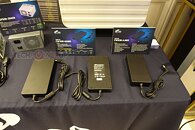Thursday, January 16th 2020

FSP at CES 2020: A Next-Gen Pure 12V PSU, and a UPS That Wants to See the World
Fortron's consumer brand, FSP, brought a handful new power products to CES 2020, besides its already launched CMT710 premium gaming chassis, the Hydro G Pro premium modular PSU from mid-2019, and Dagger Pro SFX PSUs. The inconspicuous-looking FSP500-30AKB looks like a cheap OEM-included PSU with rear 80 mm exhaust, which comes included with your case, and which you immediately discard. Only that it's possibly the most innovative thing FSP brought to CES. This PSU is being designed for Intel's upcoming PC spec that does away with the 5 V, 5 Vsb, and 3.3 V power domains altogether.
The pure-12 V PSU has only two domains: +12 V and +12 Vsb. What this means is a goodbye to the bulky 24-pin ATX power connector. The PSU only feeds 12 V to your motherboard, which uses onboard VRM and DC-to-DC switching to put out the lower voltage domains, including power for your SATA storage devices. The 24-pin connector is effectively reduced to a new 10-pin connector that only has 12 V and 12 Vsb cabling. Other cables include 8-pin EPS connectors for your CPU VRM, and 6+2 pin PCIe connectors for your graphics cards. EPS and PCIe power are purely 12 V-based standards already. The 5-pin connector is less than half as thick as your 24-pin connector, and 2 pins wider than an EPS connector. Some of the more premium PSUs may user thicker gauge wires for this connector.Next up is the Emergy 1000, a UPS dressed like a travel bag, with wheels, handle, and a plastic body to boot, which is ready to hit the road. It also has a lid with a bag-like zipper, which opens up a compartment where you tuck in its 3-pin AC cable. Inside is a sealed lead acid battery (and not lithium-ion), and a 1.5 kVA pure sine-wave AC inverter. The charging component pulls 600 W off the wall to rapidly recharge the battery (most 1.5 kVA UPSes pull around 150 W). Besides taking in 3-pin AC (100-240 VAC wide input range), the Emergy 1000 also takes in 12 V DC from third-party solar panels. Unfortunately, FSP didn't put out any official Ah figures for the battery.
The pure-12 V PSU has only two domains: +12 V and +12 Vsb. What this means is a goodbye to the bulky 24-pin ATX power connector. The PSU only feeds 12 V to your motherboard, which uses onboard VRM and DC-to-DC switching to put out the lower voltage domains, including power for your SATA storage devices. The 24-pin connector is effectively reduced to a new 10-pin connector that only has 12 V and 12 Vsb cabling. Other cables include 8-pin EPS connectors for your CPU VRM, and 6+2 pin PCIe connectors for your graphics cards. EPS and PCIe power are purely 12 V-based standards already. The 5-pin connector is less than half as thick as your 24-pin connector, and 2 pins wider than an EPS connector. Some of the more premium PSUs may user thicker gauge wires for this connector.Next up is the Emergy 1000, a UPS dressed like a travel bag, with wheels, handle, and a plastic body to boot, which is ready to hit the road. It also has a lid with a bag-like zipper, which opens up a compartment where you tuck in its 3-pin AC cable. Inside is a sealed lead acid battery (and not lithium-ion), and a 1.5 kVA pure sine-wave AC inverter. The charging component pulls 600 W off the wall to rapidly recharge the battery (most 1.5 kVA UPSes pull around 150 W). Besides taking in 3-pin AC (100-240 VAC wide input range), the Emergy 1000 also takes in 12 V DC from third-party solar panels. Unfortunately, FSP didn't put out any official Ah figures for the battery.





35 Comments on FSP at CES 2020: A Next-Gen Pure 12V PSU, and a UPS That Wants to See the World
There are tons of existing proprietary solutions similar to this, from older SFFs to newest servers. Same approach: 12V&12VSB(or ~11VSB) from PSU and vregs on motherboard.
Given how efficient switching regulators nowadays are and how small the power usage is on +5V&3V rails, you can make everything with minimal PCB footprint and barely any heat.
And just like with new Mac Pro, or the old Fujitsu/Lenovo SFFs, if you need 5V/3.3V for peripherals - just hook it up to a motherboard power connector.
-You call it both a 10-pin and a 5-pin. I guess it's 10 in two rows of 5?
(-A side note: is it a "standard" mini-fit Jr connector like the 24-pin, EPS and PCIe, or a different style?)
-A 2x5-pin connector would be one pin wider than an 8-pin EPS, not two.
-By "less than half as thick", do you mean less than half as wide?
Also, any info on the cable pinout? Is it 4x12V, 1X12VSB, 5xGND, or something else?
--I wonder how small regulators can go, like for something inline, maybe small enough not to affect aesthetics
Seeing such a thing gave me quite the smile earlier today when first reading this announcement. :lovetpu:
Just think how much vdroop you need to compensate when supplying sub-1V to the modern CPU, if they move it to the PSU... and how thick the wiring should be to handle peak loads of ~100A even on consumer end of the market. That's ridiculous, and I'm not even gonna start on other minor rails.
I also have concerns about putting the 3.3V and 5V voltage regulator circuitry on the motherboard. Firstly, modern motherboards are crowded enough, where is that extra hardware going to live? Are low-end motherboards going to forgo this circuitry, and hence SATA ports, entirely? Secondly, if your motherboard fails and you're using Windows, you lose an activation (not Intel's fault, but definitely something to consider).But since the non-12V rails don't see a lot of use, they shouldn't see a lot of stress either. And most high-end PSUs simply derive these rails from 12V anyway.
Also: phone quick charging up until recent flagships has been <20W (there's a current arms race for ever higher amounts of watts for your quick charging, but most are still in the sub-20 range). 15W isn't too far from that, but 100W sure is. Just imagine the infrastructure if every type-C port on your PC (or laptop!) needed to be ble to supply 100W simultaneously. That would be insane! And let's not forget that 20V doesn't exist in desktop PCs, so any USB PCIe card supporting >60W output (12V5A) would need a boost converter on board to create that voltage. The same goes for 9V, which is currently the most common voltage for phone fast charging over USB-PD. Most PCs with PD output support only support a limited subset of its voltages and at reasonable amperages.
I"m thinking the alternative would be to change USB standards to use 12v and force attached devices become responsible for converting whats needed for 5v or 3.3v or whatever. Thats still assuming this all changes to a pure 12v system.
www.asus.com/Motherboard-Accessories/USB-31-UPD-PANEL/
Phone chargers for some models are already up to 120W, which is a bit silly, but i sincerely think that the norm will be well over 15W for all flagships in a year or so.
Also I don’t think that it would be necessary to be able to output full 100W from all ports, as they could share the on board regulators to some extent. Like 250W max total over 8 ports or something like that.
On the other hand 24W (12V2A) or 27W (9V3A) is perfectly fine for fast charging any phone, no matter its capacity, and those >40W chargers are frankly just express speed battery charge cycle depletion devices with limited real world utility. Not to mention that none of those batteries can handle that amount of power fed into them for more than a brief while. Keeping host power delivery requirements is an eminently sensible thing to do, but I do see room for the spec to grow a bit in the future. Given that running multiple high power devices like this is also very unlikely it would be reasonable to cap shared output at something conservative like 5-6A.
Unless, of course, you want all your future motherboards to be SSI EEB form factor and $500 minimum.
With the above we could have as many usb ports as we like and essentially unlimited amount could pump out 12V directly from the psu, two could pump out the maximum amps allowed for 9V and the 5V devices could share like 12 amps or so over a single voltage plane and a regulator. Each port would require an USB-PD voltage selector/amp monitoring chip (these are around 1$ a piece) to select the voltage plane and protect against shorts. The 5 and 9 V regulators at the specified amp ratings would cost maybe 5-10$ each. I fear that the usb-c connectors would be the most expensive components in this vision.
I do agree that supporting 20V over usb-pd with 12V power supplies is a bad idea as far as motherboards go.
This one would be $2 and I’m sure there are cheaper options available. You just pass through the cc pins to it and it handles the power delivery independently from the other communication stuff already present with any usb3.x host controller. 5A max. Ddr5 and pcie4+ already make extra layers necessary, but which are not really needed in the IO area, giving us much needed real estate to apply the extra chips and power planes. It would cost a bit extra, but not that much. Itx would be a problem space wise, if you would wish to have anything but a few usb-c ports at the back.